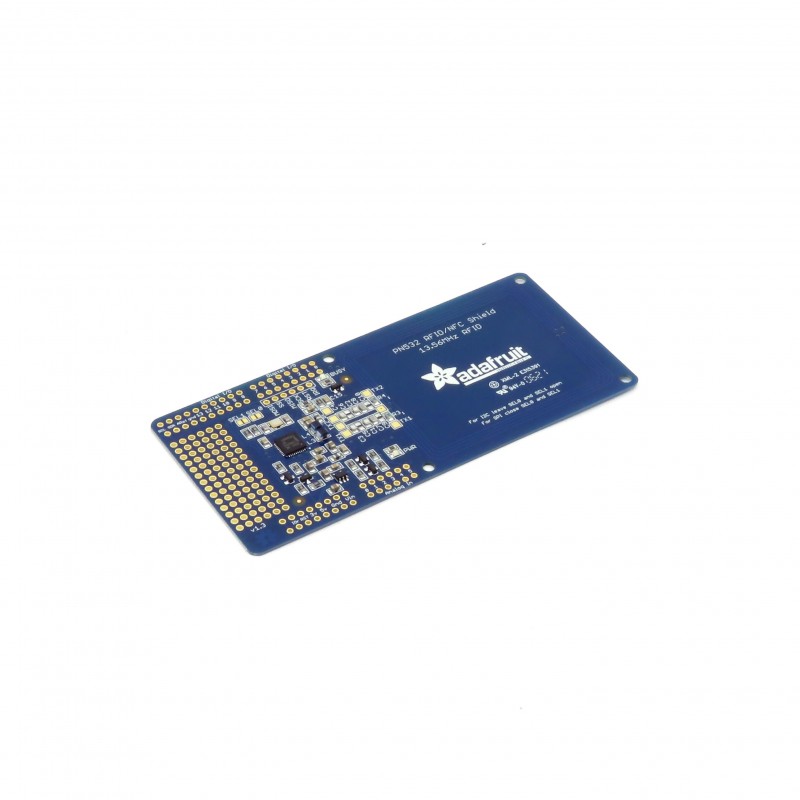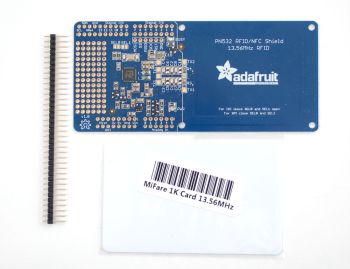


Description
We've taken our popular Adafruit PN532 breakout board and turned it into a shield - the perfect tool for any 13.56MHz RFID or NFC application. The Adafruit NFC shield uses the PN532 chip-set (the most popular NFC chip on the market) and is what is embedded in pretty much every phone or device that does NFC. This chipset is very powerful, and can pretty much do it all, such as read and write to tags and cards, communicate with phones (say for payment processing), and 'act' like a NFC tag. While the controller has many capabilities, our Arduino library currently only supports reading/writing tags, and does not support phone-to-shield communication, tag emulation (which requires an external 'secure element' only available from NXP) or other more advanced features at this time.
NFC (Near Field Communications) is a way for two devices very close to each other to communicate. Sort of like a very short range bluetooth that doesn't require authentication. It is an extension of RFID, so anything you can do with RFID you can do with NFC.
Because it can read and write tags, you can always just use this for RFID-tag projects. We carry a few different tags that work great with this chip. It can also work with any other NFC/RFID Type 1 thru 4 tag (and of course all the other NXP MiFare type tags)
The Adafruit shield was designed by RF engineers using the best test equipment to create a layout and antenna with 10cm (4 inch) range, the maximum range possible using the 13.56MHz technology. You can easily attach the shield behind a plastic plate with standoffs and still read cards through a (non-metal) barrier.
This shield is designed to use I2C or SPI communication protocols. I2C is the default, as it uses fewer pins: analog 4 and 5 are used for I2C (of course you can still connect other I2C devices to the bus). Digital #2 is used for "interrupt" notification. This means you don't have to sit there and 'poll' the chip to ask if a target tag has been found, the pin will pull low when a card, phone, etc is within range. You can adjust which pin is used if you need to keep digital #2 for something else. It is also easy to change the shield over to SPI where you can use any 4 digital pins by shorting two solder jumpers on the top of the PCB. Compatible with any "classic" Arduino - NG, Diecimilla, Duemilanove, UNO - as well as Mega R3 or later. For using the I2C interface with Mega R2 or earlier, two wires must be soldered as the I2C pins are in a different location on earlier Megas.
Details: 2.1" (53.3mm) x 4.7" (117.7mm) and 0.425" (1.1mm) thick.
Download
Code: 789
Manufacturer BTC Korporacja sp. z o. o. Lwowska 5 05-120 Legionowo Poland sprzedaz@kamami.pl 22 767 36 20
Responsible person BTC Korporacja sp. z o. o. Lwowska 5 05-120 Legionowo Poland sprzedaz@kamami.pl 22 767 36 20
Board with ATmega2560 microcontroller (256 kB Flash, 8 kB RAM, 4 kB EEPROM) clocked at 16 MHz. USB-UART converter based on the ATmega16u2 chip. The user has at his disposal, among others: 54 I/O lines, 14 PWM channels, 16 analog inputs.
No product available!
Board with Atmel ATmega328 microcontroller from the AVR family, there are 14 I / O lines, 6 PWM channels and 6 analog inputs. The additional ATmega16U4 microcontroller realizes communication via the USB interface
Expansion board with GSM/GPRS module designed for Arduino and Raspberry Pi. It uses the Quectel M95 chip, the board has two audio connectors, a microSD slot and a dual SIM slot. A-GSM II Shield
No product available!
Module with a radio receiver operating at 315 MHz for Arduino. DFRobot TEL0075
Ethernet network module with W5500 chip and PoE (Power over Ethernet) function. It communicates via the SPI interface, it has a built-in TCP/IP stack. DFRobot DFR0850
Expansion board based on the Wiznet W5200 Ethernet system. It allows you to easily connect Arduino to an Ethernet network. DFRobot DFR0125
No product available!
KAmodNFC is an expansion board with M24LR64E-R chip – dynamic tag with 64kb EEPROM memory and dual communication interface (I2C/RF). On board is placed also signalization of energy harvesting function, which is in M24LR64E-R chip embedded.
Module with Himax HM-01B0 camera and Ethernet communication dedicated to Arduino Portenta H7 boards. Arduino ASX00021
No product available!
The Arduino expansion board is dedicated to applications that use NB-IoT communication. Thanks to the GNSS (Global Navigation Satellite System) module, it supports GPS, GLONASS, Galileo, QZSS and BeiDou navigation systems. The module is supplied with the voltage from 7 to 12 V. DFRobot DFR0572
UART-RS485 converter module. It enables communication of Arduino boards with industrial modules. DFRobot DFR0259
Advanced expansion board for Arduino. It has support for mini-SIM cards and NB-IoT cards. Thanks to the GNSS module (Global Navigation Satellite System), it supports GPS, GLONASS, Galileo, QZSS and BeiDou GPS navigation systems. The module is powered by 7-12V voltage. DFRobot DFR0572
Ethernet board with mini SD card slot based on W5100 controller.
Shield for STM32 series Nucleo, XNucleo and Arduino series for communication via RS485 and CAN interfaces (CAN is only available for Nucleo and XNucleo plates). Shield is based on MAX3485 and SN65HVD230 systems
Expansion board based on the Wiznet W5200 Ethernet chip. It allows you to easily connect the Arduino to the Ethernet network. DFRobot DFR0272
Arduino compatible shield for the ESP8266 WiFi SoC – a leading platform for Internet of Things (IoT) or WiFi-related projects. WRL-13287
No product available!
The Arduino Ethernet Shield 2 allows an Arduino Board to connect to the internet. It is based on the Wiznet W5500 Ethernet chip. The Wiznet W5500 provides a network (IP) stack capable of both TCP and UDP. There is an onboard micro-SD card slot, which can be used to store files for serving over the network. It is compatible with the Arduino Uno and Mega
No product available!
A wireless overlay designed for Arduino tiles. Equipped with a connector compatible with Xbee modules and a microSD card slot. Arduino A100065
The CAN-BUS Arduino Shield v2.0 can be stacked on an Arduino UNO, Arduino Leonardo or Arduino MEGA board. The shield integrates an MCP2515 CAN-BUS chip on the shield and has a CAN-BUS transceiver function. With an on-board DB9 and CAN-BUS connector you can choose a suitable port according to your host device. There is also an integrated MicroSD socket for data storage. DFR0370

Adafruit 789 - Adafruit PN532 NFC/RFID Controller Shield for Arduino + Extras
